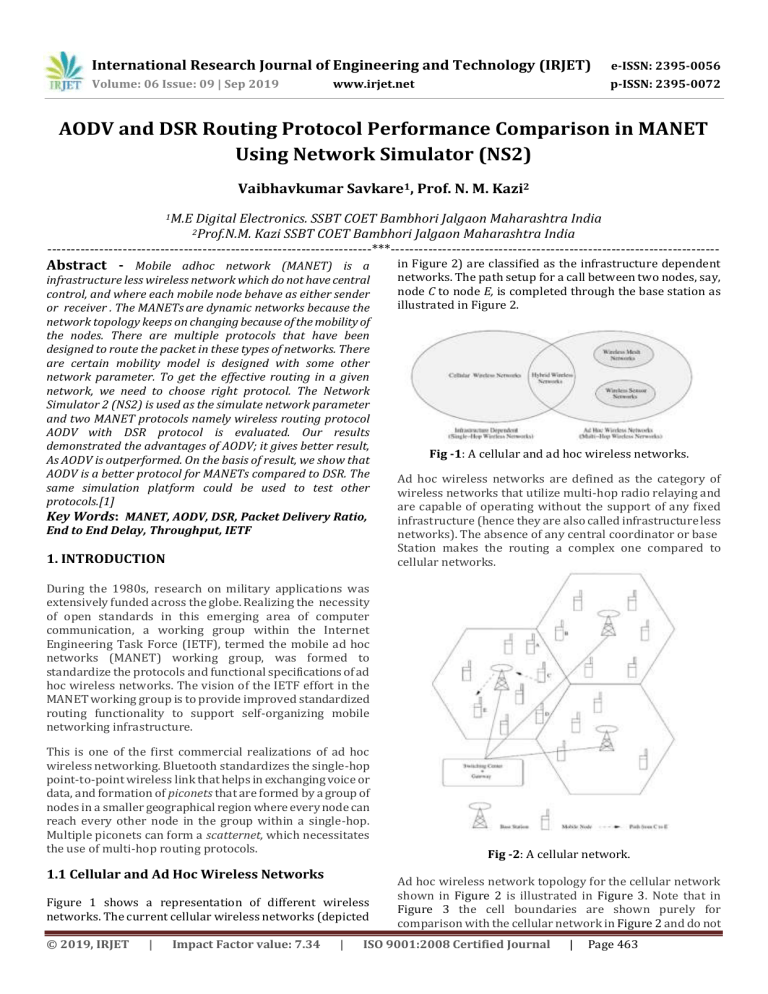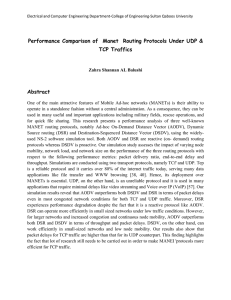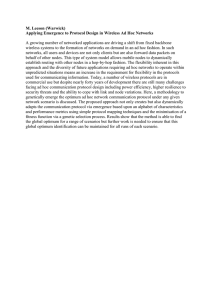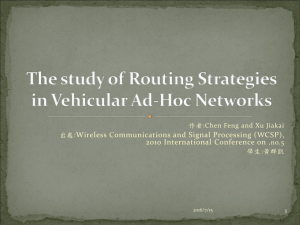IRJET-AODV and DSR Routing Protocol Performance Comparison in MANET using Network Simulator (NS2)
advertisement

International Research Journal of Engineering and Technology (IRJET) e-ISSN: 2395-0056 Volume: 06 Issue: 09 | Sep 2019 p-ISSN: 2395-0072 www.irjet.net AODV and DSR Routing Protocol Performance Comparison in MANET Using Network Simulator (NS2) Vaibhavkumar Savkare1, Prof. N. M. Kazi2 1M.E Digital Electronics. SSBT COET Bambhori Jalgaon Maharashtra India Kazi SSBT COET Bambhori Jalgaon Maharashtra India ---------------------------------------------------------------------***---------------------------------------------------------------------2Prof.N.M. Abstract - Mobile adhoc network (MANET) is a infrastructure less wireless network which do not have central control, and where each mobile node behave as either sender or receiver . The MANETs are dynamic networks because the network topology keeps on changing because of the mobility of the nodes. There are multiple protocols that have been designed to route the packet in these types of networks. There are certain mobility model is designed with some other network parameter. To get the effective routing in a given network, we need to choose right protocol. The Network Simulator 2 (NS2) is used as the simulate network parameter and two MANET protocols namely wireless routing protocol AODV with DSR protocol is evaluated. Our results demonstrated the advantages of AODV; it gives better result, As AODV is outperformed. On the basis of result, we show that AODV is a better protocol for MANETs compared to DSR. The same simulation platform could be used to test other protocols.[1] Key Words: MANET, AODV, DSR, Packet Delivery Ratio, End to End Delay, Throughput, IETF 1. INTRODUCTION in Figure 2) are classified as the infrastructure dependent networks. The path setup for a call between two nodes, say, node C to node E, is completed through the base station as illustrated in Figure 2. Fig -1: A cellular and ad hoc wireless networks. Ad hoc wireless networks are defined as the category of wireless networks that utilize multi-hop radio relaying and are capable of operating without the support of any fixed infrastructure (hence they are also called infrastructure less networks). The absence of any central coordinator or base Station makes the routing a complex one compared to cellular networks. During the 1980s, research on military applications was extensively funded across the globe. Realizing the necessity of open standards in this emerging area of computer communication, a working group within the Internet Engineering Task Force (IETF), termed the mobile ad hoc networks (MANET) working group, was formed to standardize the protocols and functional specifications of ad hoc wireless networks. The vision of the IETF effort in the MANET working group is to provide improved standardized routing functionality to support self-organizing mobile networking infrastructure. This is one of the first commercial realizations of ad hoc wireless networking. Bluetooth standardizes the single-hop point-to-point wireless link that helps in exchanging voice or data, and formation of piconets that are formed by a group of nodes in a smaller geographical region where every node can reach every other node in the group within a single-hop. Multiple piconets can form a scatternet, which necessitates the use of multi-hop routing protocols. 1.1 Cellular and Ad Hoc Wireless Networks Figure 1 shows a representation of different wireless networks. The current cellular wireless networks (depicted © 2019, IRJET | Impact Factor value: 7.34 | Fig -2: A cellular network. Ad hoc wireless network topology for the cellular network shown in Figure 2 is illustrated in Figure 3. Note that in Figure 3 the cell boundaries are shown purely for comparison with the cellular network in Figure 2 and do not ISO 9001:2008 Certified Journal | Page 463 International Research Journal of Engineering and Technology (IRJET) e-ISSN: 2395-0056 Volume: 06 Issue: 09 | Sep 2019 p-ISSN: 2395-0072 www.irjet.net carry any special significance. The path setup for a call between two nodes, say, node C to node E, is completed through the intermediate mobile node F, as illustrated in Figure 3. Wireless mesh networks and wireless sensor networks are specific examples of ad hoc wireless networks. Circuit switched Seamless connectivity High cost and time of deployment Application domain civilian and commercial Major goals to maximize the call acceptance ratio and minimize the call drop ratio Packet switched Frequent path breaks due to Mobility Quick and cost effective deployment Application domain include battlefield, emergency search and rescue and collaborative computing Main aim is to find paths with minimum overhead and also quick reconfiguration of broken paths. 2. SOFTWARE Network Simulator (Version 2), generally known as NS2, is just an occasion driven tool that is helpful in concentrate the dynamic idea of correspondence systems. Recreation of wired and in addition remote system capacities and conventions (e.g., steering calculations, TCP, UDP) should be possible utilizing NS2. As a rule, NS2 gives clients a method for indicating such system conventions and finding their relating practices. Fig -3: An ad hoc wireless network. The major differences between cellular networks and ad hoc wireless networks are summarized in Table 5.1. The presence of base stations simplifies routing and resource management in a cellular network as the routing decisions are made in a centralized manner with more information about the destination node. But in an ad hoc wireless network, the routing and resource management are done in a distributed manner in which all nodes coordinate to enable communication among themselves. This requires each node to be more intelligent so that it can function both as a network host for transmitting and receiving data and as a network router for routing packets from other nodes. Hence the mobile nodes in ad hoc wireless networks are more complex than their counterparts in cellular networks. [2] Table -1: Differences between cellular networks and ad hoc wireless networks [2] Cellular Networks Fig. 4 shows the basic architecture of NS2. NS2 provides users with an executable command “ns” which takes one input argument, the name of a Tcl simulation scripting file. In most cases, a simulation trace file is created and is used to plot graph and/or to create animation.[3] Fig -4: Basic Architecture of NS After simulation, NS2 outputs either text-based simulation results. To interpret these results graphically and interactively, tools such as NAM (Network AniMator) and XGraph are used. To analyze a particular behavior of the network, users can extract a relevant subset of text-based data and transform it to a more conceivable presentation. Ad hoc Wireless Networks 3. Simulation and Result Fixed infrastructure based Infrastructure less Single hop wireless links Multi hop wireless link Guaranteed bandwidth Shared radio signal As already outlined, we have taken two On-demand (Reactive) routing protocols, namely Ad hoc On-Demand Distance Vector Routing (AODV) and Dynamic Source Routing (DSR). The mobility model used is Random waypoint mobility model because it models the random © 2019, IRJET | Impact Factor value: 7.34 | ISO 9001:2008 Certified Journal | Page 464 International Research Journal of Engineering and Technology (IRJET) e-ISSN: 2395-0056 Volume: 06 Issue: 09 | Sep 2019 p-ISSN: 2395-0072 www.irjet.net movement of the mobile nodes. For all the simulations, the same movement models were used, the number of traffic sources was fixed at 10, the maximum speed of the nodes was set to 20m/s and the simulation time was varied as 10s, 15s, and 20s. Table -2: Scenario 1 for implementation of AODV and DSR Scenario 1 for implementation of AODV and DSR Parameter Value 10 Number of nodes Simulation Time Pause Time Environment SIze Transmission Range Traffic Size Packet Size Packet Rate Maximum Speed Queue Length Simulator Mobility Model Antenna Type 10 sec 5ms 800x800 250m CBR 512 bytes 5 packets/s 20 m/s 50 NS2 Random Waypoint Omnidirectional Fig -6: A Screenshot of nodes of DSR NAM – Network animator. Ad hoc On-Demand Distance Vector Routing (AODV) and Dynamic Source Routing (DSR). The mobility model used is Random waypoint mobility model because it models the random movement of the mobile nodes. For all the simulations, the same movement models were used, the number of traffic sources was fixed at 10, the maximum speed of the nodes was set to 20m/s and the simulation time was varied as 10s, 15s, and 20s. Fig -7: X Graph of 10 seconds simulation time of AODV The Figure 7 shows the X graph of AODV. By the Figure we see that as the simulation start the packet received and packet loss is initially zero, because initially there is no CBR connection and nodes taking their right place. As the CBR connections establish between the nodes the number of packet received increases but no packet loss is there, it means all generated packets are being received by the nodes. But the packet loss increases substantially on the simulation time increases. Finally the packet received is more than the packet loss. Fig -5: A Screenshot of nodes of AODV NAM – Network animator. © 2019, IRJET | Impact Factor value: 7.34 | ISO 9001:2008 Certified Journal | Page 465 International Research Journal of Engineering and Technology (IRJET) e-ISSN: 2395-0056 Volume: 06 Issue: 09 | Sep 2019 p-ISSN: 2395-0072 www.irjet.net initial packet loss and DSR should not be prefer to setup a MANET for a small amount of time because initially there is packet loss is very high. If we have to use the MANET for a longer duration then both the protocols can be used, because after sometimes both the protocols have same ratio of packet delivering. But AODV have very good packet receiving ratio in comparison to DSR. The two protocols Ad hoc On-Demand Distance Vector Routing (AODV) and Dynamic Source Routing (DSR) have been compared using simulation, it would be interesting to note the behavior of these protocols on a real-life test bed. In this work other network parameters such as number of mobile nodes, traffic type-CBR, simulation area etc. are kept constant. Whereas the simulation time is varied in the three different simulation scenarios. It would be interesting to observe the behavior of these two protocols by varying these network parameters. REFERENCES Fig -8: X Graph of 10 seconds simulation time of DSR Dipak Shrivastava. Vibhor Sharma. Dheresh Soni, “Optimization of CSMA (Carrier Sense Multiple Access) over AODV,DSR & WRP Routing protocol,” 978-1-72811253-4 2019 IEEE [2] C. Siva Ram Murthy and B. S. Manoj, “Ad Hoc Wireless Networks”, chpt 5, pp. 206-210 [3] Isaariyakul, T., & Hossain, E. (n.d.). Introduction to Network Simulator NS2 (Second ed.). doi:10.1007/978-1-4614-1406-3 [1] The Figure 8 shows the X graph of DSR. By the Figure we see that as the simulation start the packet received and packet loss is initially zero, because initially there is no CBR connection and nodes taking their right place. As the CBR connections establish the number of packet lost increases very much as compare to packet received. It shows that mostly generated packets are being dropped by the nodes. But the packet loss decreases substantially on the simulation time increases, and number of packet received increases substantially on the simulation time increases. Similarly carrying out remaining two scenarios and comparing results we concluded. 4. Conclusions We have compared two On-demand routing protocols, namely, Ad hoc On-Demand Distance Vector Routing (AODV) and Dynamic Source Routing (DSR). The simulation of these protocols has been carried out using Ns-2 simulator on a Atom, 2.0Ghz /RAM-2 GB /HDD- 120GB computer and windows 7/ Ubuntu operating system. Three different simulation scenarios are generated and the simulation time has varied from 10sec, 15sec and 20 sec. Other network parameters are kept constant during the simulation. It is observed that the packet loss is very less in case of AODV, initially but it increases substantially on the simulation time increases. In case of DSR simulation the packet loss is very high initially but it decreases substantially on the simulation time increases. So, we can conclude that if the MANET has to be setup for a small amount of time then AODV should be prefer due to low © 2019, IRJET | Impact Factor value: 7.34 | ISO 9001:2008 Certified Journal | Page 466



